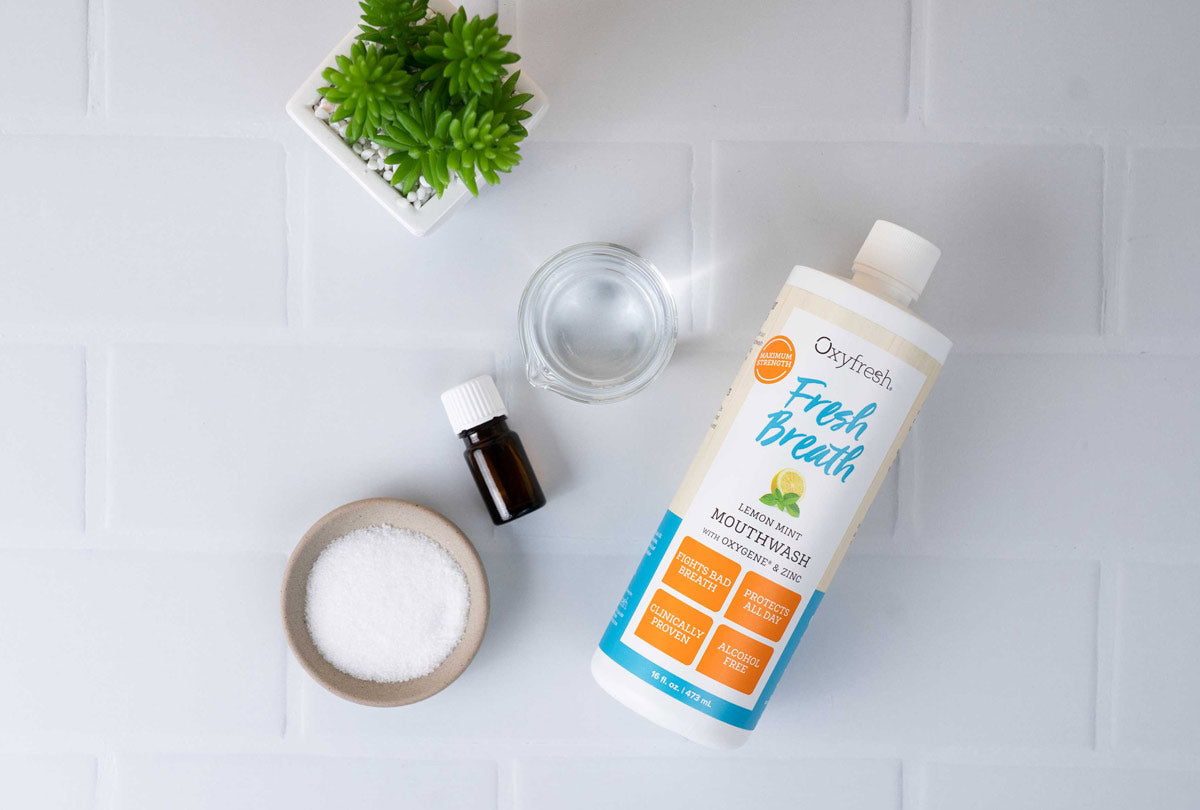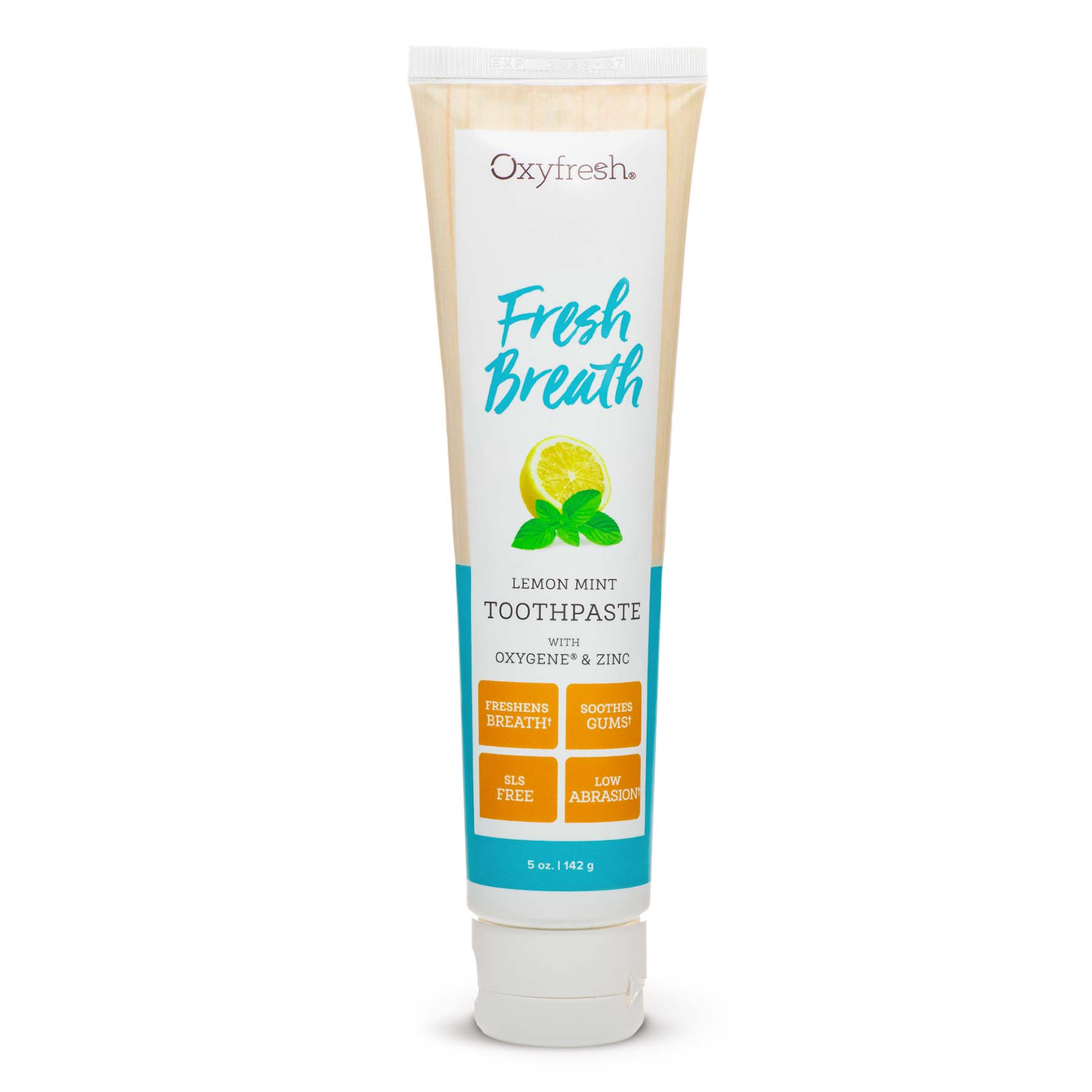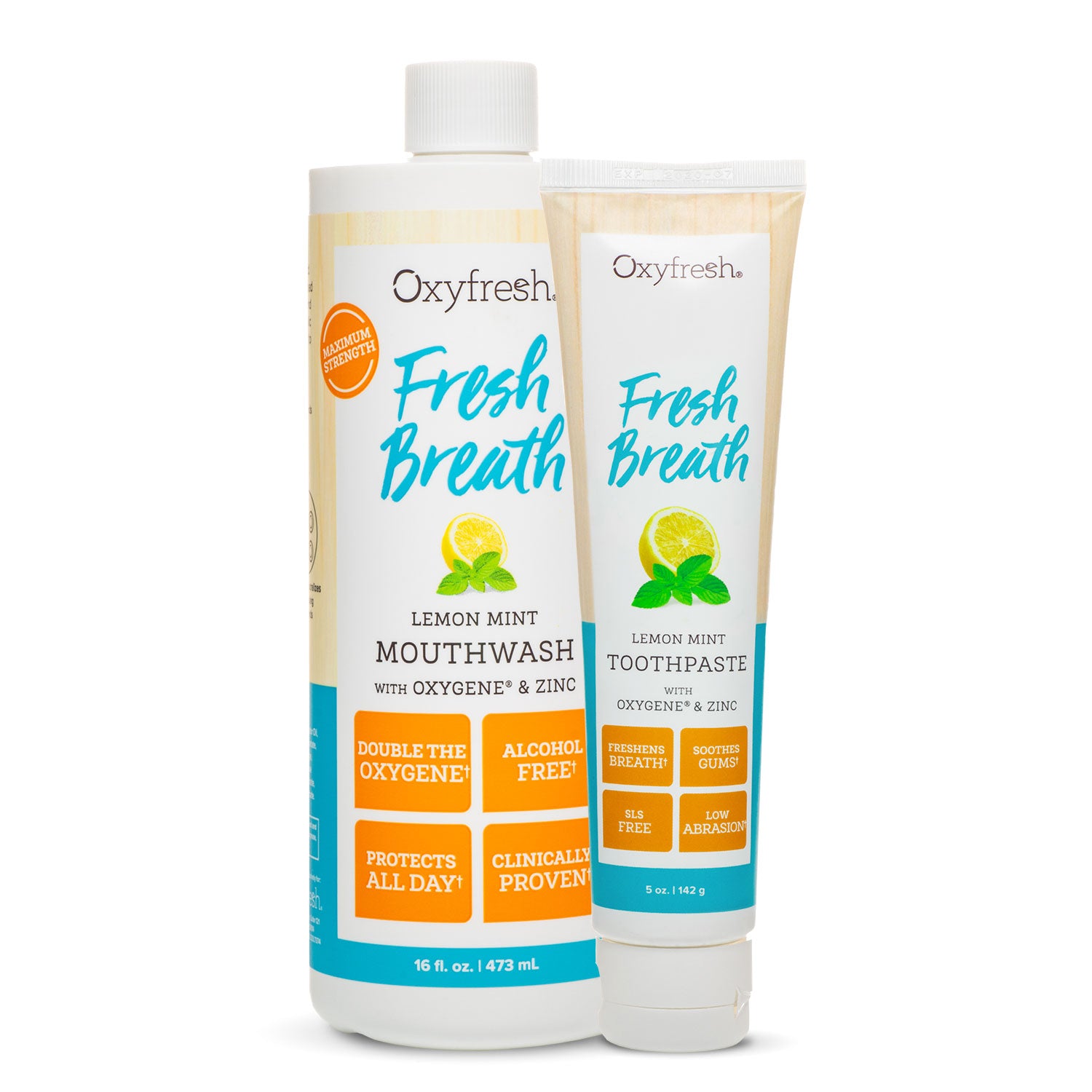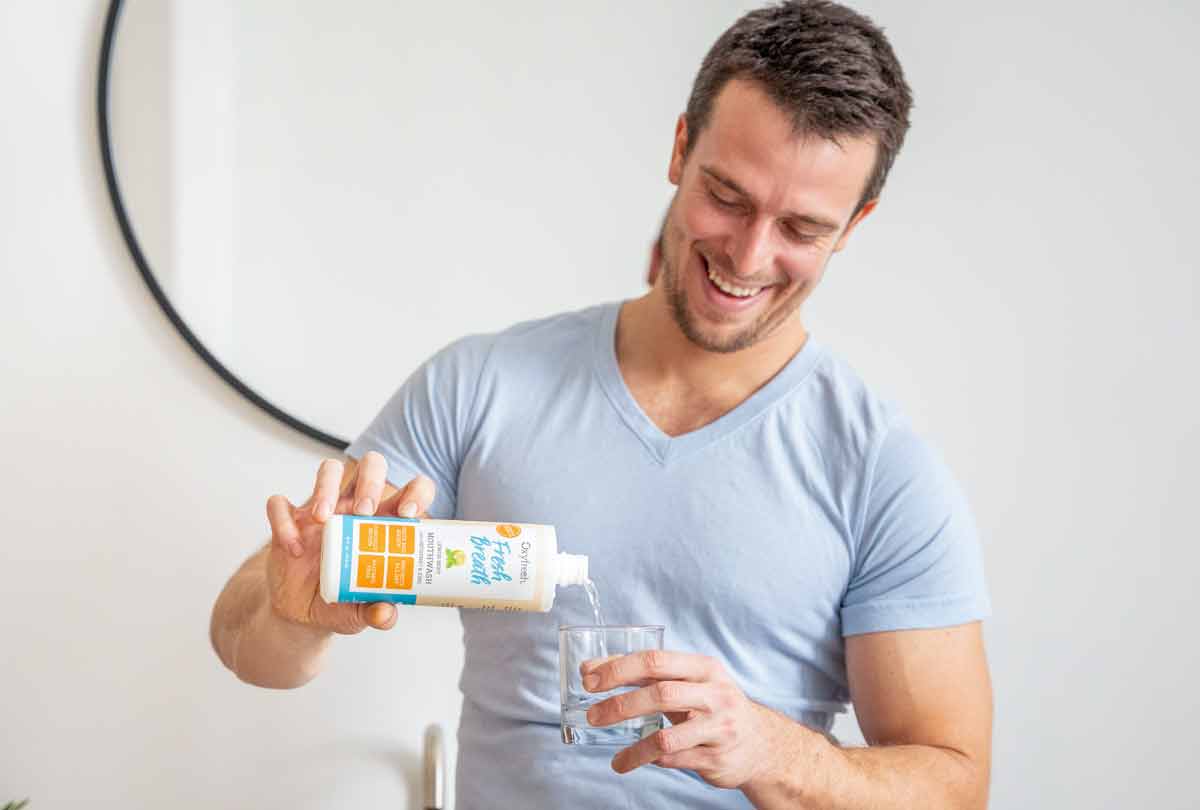"Stains teeth!" "More tartar!" "Guaranteed bad breath or your money back!"
Imagine if marketers put these phrases front and center on mouthwash bottles. Well, here’s a dirty little secret: many mouthwashes are doing the exact opposite of what consumers want them to do!
Become a savvy swisher and check out which mouthwash ingredients to avoid and which ones are best for a healthier smile.
Mouthwash Ingredients to Avoid
Alcohol
Alcohol tops the list of mouthwash ingredients to avoid, but this is no easy task. Nearly every mouthwash bottle you’ll see lining store shelves contains alcohol, between 14% and 26.9% alcohol.
Many people believe that alcohol in mouthwash will "kill the bad breath germs," but in truth, the amount of alcohol is too little to have an antiseptic effect. (For comparison, disinfecting alcohol is 70%-99% alcohol.) Instead, alcohol in mouthwash is used as a stabilizer and carrier agent for active ingredients like menthol.
So what’s the big deal about alcohol in mouthwash?
- Alcohol dries out the mouth. A dry mouth causes Volatile Sulfur Compounds (the molecules that cause bad breath) to multiply at a rapid pace. This leads to, ironically, even worse breath later in the day. Saliva also plays a key role in remineralizing teeth and fighting decay. If your mouth is always dry due to an unhealthy mouthwash habit, you’re setting yourself up for higher risk of cavities.
- Alcohol can burn and irritate the mouth. Ethanol, especially paired with menthol, can trigger that awful burning sensation. While many think "the burn means it’s working," here’s an aha moment: mouthwash isn’t supposed to hurt. The burn can be especially problematic if you often get canker sores. Alcohol in mouthwash can also cause tissue sloughing, where the lining of your inner cheeks peels off.
- Alcohol disrupts the oral microbiome. Just like your gut contains a community of bacteria, so does the mouth. This community is called the oral microbiome. When the balance of bacteria in your mouth is thrown off (more bad bacteria vs. good bacteria), issues like bad breath, gingivitis and mouth ulcers can occur. Alcohol mouthwash is bad for the oral microbiome because of its drying effect, which causes a more acidic environment in the mouth. Fortunately, there are many ways to quickly balance your oral microbiome, including kicking your alcohol mouthwash habit to the curb.
Dyes
Yellow #5, Blue #1, Red #40 ... the rainbow of colors in your mouthwash could be doing your teeth a disservice ... in particular, staining them.
Sure, we all want a smile free of cavities and gum problems, but let’s be honest: we’re all a little vain when it comes to the color of our teeth. And since we’re not going to give up coffee any time soon, why would we put MORE stuff onto our teeth that could stain them?
Bottom line: Dyes may make mouthwashes look "prettier," but we’ll take our bright smiles instead, thank you very much.
Speaking of Teeth Stains ...
If you’ve been prescribed a chlorhexidine mouthwash, which is available by prescription only to aid the gums, make sure you only use it as directed. Chlorhexidine is a powerful antiseptic, but it isn’t safe for long-term use, as it can cause altered taste (sometimes permanently), teeth staining, tongue swelling, and tartar buildup. Additionally, some people have allergic reactions to chlorhexidine gluconate mouthwashes.
Best Mouthwash Ingredients for Gingivitis
Xylitol
Xylitol (pronounced zai-luh-taal) is a natural sweetener (not an artificial sweetener) found in certain fruits, veggies, and plant stalks/husks. What’s noteworthy about xylitol is it tastes like sugar (relative sweetness is only 3% less than actual sugar), but it doesn’t cause the blood sugar to rise significantly, which is good news for diabetics.
In mouthwash, xylitol does more than deliver a tasty swish – it actually IMPROVES oral health by helping to prevent tooth decay and helping to remove plaque. Here’s how:
Oral bacteria like Streptococcus mutans and Streptococcus sobrinus, which are major contributors to tooth decay and cavities, need an acidic environment to flourish. The non-acidic nature of xylitol stifles their growth. They can’t use xylitol as a nutrient or metabolize it, so it stops the bacteria "breeding" process.
At the same time, xylitol helps blocks production of polysaccharides, goop that binds plaque together, making it less bulky and sticky on the teeth.
Xylitol also increases saliva production, which helps with cavity prevention by stopping the growth of certain bacteria. For those who don’t use fluoride dental products, toothpastes and mouthwashes with xylitol fill in that gap. Learn more about why xylitol may be the biggest game changer for dental hygiene.
Essential Oils
Tired of the synthetic menthol BURN of traditional mouthwashes? We hear that! That’s why essential oils are some of the best mouthwash ingredients.
Not only do they deliver a refreshing, hydrating and tasty swish, but they’re also among the best mouthwash ingredients for gingivitis because of their antioxidant and antiseptic properties. They help fight gum inflammation, harmful bacteria, and bad breath while soothing and stimulating the gums.
Best essential oils in mouthwash:
- Orange Essential Oil
- Lemon Essential Oil
- Lime Essential Oil
- Cinnamon Essential Oil
- Clove Essential Oil
- Grapefruit Essential Oil
- Bergamot Essential Oil
- Tea Tree Essential Oil
- Peppermint Essential Oil
- Spearmint Essential Oil
Note to the DIY folks: Just because an essential oil comes from nature doesn’t mean it’s safe to go in your mouth. Before you make your own essential oil mouthwash, make sure it’s approved for oral care and follow proper dilution instructions, as essential oils are 30 times more potent than herbs.
Chlorine Dioxide - A.K.A. Oxygene®
Um, is this like the stuff that goes in pool water?
Don’t worry. Although they share part of a name, chlorine and chlorine dioxide are molecularly not the same thing!
Oxygene®, the star of our dental products, is a powerful, non-toxic oxidizer. An oxidizer means it’s reactive. It reacts with harmful bacteria, rendering them inactive.
In mouthwash, chlorine dioxide is a fantastic active ingredient because it oxidizes Volatile Sulfur Compounds (bad breath molecules) and bacteria linked to gingivitis and decay.
Why chlorine dioxide / Oxygene® is one of the best mouthwash ingredients for gingivitis:
- Safe for long-term use: chlorine dioxide purifies without causing dryness, staining, tissue irritation, or disruption to the oral microbiome.
- Tasteless & odorless: no one wants to swish with burning or bitter-tasting mouthwash.
- Freshens breath in 60 seconds: when chlorine dioxide meets an acidic environment (like a mouth with gingivitis), it’s activated to quickly neutralize stinky sulfur compounds and keep the breath fresh all day.
Best Mouthwash Formula on the Market
Destined to be your new favorite mouthwash, Oxyfresh fluoride-free Fresh Breath Lemon Mint Mouthwash is the pioneer of the alcohol-free mouthwash movement.
Loved by dentists, hygienists and fresh breath fans since 1984, it features all the best mouthwash ingredients for a healthier smile: xylitol, essential oils, and a proprietary blend of chlorine dioxide (Oxygene®) to give you instant, all-day fresh breath. No burning, no staining dyes, no bad mouthwash ingredients ... only the good stuff!
Keep in mind, this is not your average, boring-old-mint mouthwash. Oxyfresh Lemon Mint Mouthwash features a crisp, refreshing blend of six natural essential oils, including lemon, orange, grapefruit, bergamot, lime and spearmint. Plus, it’s infused with aloe vera for a hydrating, ultra-soothing swish.
Does Oxyfresh Mouthwash Work? Proof Is in the Swish.
In a double-blind clinical study of 50 periodontitis patients (patients with severe gum disease), Oxyfresh Lemon Mint Mouthwash and Lemon Mint Toothpaste went up against the top store-brand mouthwash with alcohol, plus store-brand toothpaste. Participants were randomly assigned to two groups and used their designated products for 12 months following a deep clean. As you can see, Oxyfresh sported better results in every category.
Oxyfresh Lemon Mint Mouthwash & Toothpaste
- 76% improvement Gingival Index
- 79% plaque reduction
- 44% reduction bad-breath bacteria
Store-Brand Mouthwash & Toothpaste
- 70% improvement Gingival Index
- 71% plaque reduction
- 34% reduction bad-breath bacteria
Now that you know which mouthwash ingredients to avoid, swish happier and get your smile in the best shape ever with Oxyfresh Fresh Breath Lemon Mint Mouthwash. We guarantee you’ll love it!






